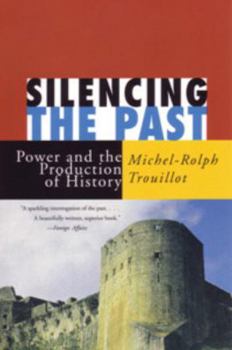Silencing the Past
Select Format
Select Condition 
Book Overview
Now part of the HBO docuseries Exterminate All the Brutes, written and directed by Raoul Peck The 20th anniversary edition of a pioneering classic that explores the contexts in which history is... This description may be from another edition of this product.
Format:Paperback
Language:English
ISBN:0807043117
ISBN13:9780807043110
Release Date:July 1997
Publisher:Beacon Press (MA)
Length:216 Pages
Weight:0.54 lbs.
Dimensions:0.6" x 5.0" x 8.3"
Customer Reviews
4 ratings
Fascinating and Well-Written
Published by Thriftbooks.com User , 18 years ago
If you liked any of Howard Zinn's books, you'll like this. Trouillot's analysis of historiography goes far beyond "history is written by the victors" to talk about the deliberate and systematic way that some voices, events, and narratives are excluded from the dominant historical record. If the first section is a little too theoretical (and, for me, it was), the heart of the book is three examples, focussing on the Sans Souci, a Haitian revolutionary; the Haitian revolution itself; and Columbus' arrival on the shores of America. These sections themselves, apart from their theoretical buttressing, are fascinating studies of historiography. A wonderful book.
Thought-provoking and essential reading
Published by Thriftbooks.com User , 20 years ago
Troulloit's broad vision of both the past and the process by which we write about the past informs this immensely impressive series of essays. While not for the general reader, students of history and anthropology as well as professional academics will love this succinct, jargon-free approach to the most essential questions of historiography.
Public History distorted
Published by Thriftbooks.com User , 23 years ago
Silencing the Past is an excellent account of how mistakes and mis-readings of history can contaminate the perspective an entire society's world view. Troulliot's book is very applicable to the realm public history. Monuments, museums, displays and the like are all examples of how history influences our every day lives. Altough, without realizing it, we assume the things that we read and see in such places are entirely true. This is a mistake, as Troulliot points out, because, the amount we do know about our history, is only a fragment of what we don't know...and that when historians create public history they can only use the information available, which is most often the product of a white, western mind, published and tagged as 'history-proper' Another factor in the use of history as a public tool is its tendency to be 'good' history. In that, all too often when history is presented to the public, it has a habit of being watered down, desanctified, and 'positively' presented. Only a curator with integrity and confidence would present a "full story," as more often than not, social taboos and political correctness prevent him from doing so. This is sad, as in the mean time, the historical process is damaged. What such a presenter of public history is doing when they present only favorable aspects of history is educating a public about half the story, which will then become part of a public world view, a world view, that is skewed in a way that will be very hard to correct. A public mind is hard to change, the more a public wants to believe something, the longer they do. Believing a positive is always easier than the alternative. This is the importance of creating a sound, fair and accurate archive of public historical knowledge.Troulliot's book serves a great purpose: it infects the reader with a historical vigilante syndrome. It tells the reader to be wary of history, but not to dismiss it. In so doing, he has created a masterpiece that informs, educates and calls the reader to act upon, and in many ways become, a vindicator of history and the historical process.
Challenging philosophical look at historical method
Published by Thriftbooks.com User , 25 years ago
Michel-Rolph Trouillot argues that in the writing of history lots of things get lost and what is lost impacts our view of the past.The first thing which is lost are some sources. For many of us there simply are no sources kept. For others there may have been historical traces but they have gotten lost or destroyed in time.The next level of such data is that when data is collected and selected for various archives there is another level of things getting lost, sources, which there and existing, are effectively lost since there were not judged worthy of archiving.Lastly, the individual historian much choose from the archival material what is important in telling the story of history the author is telling. Again in this process of selection events and parts of history get lost and suppressed.What emerges as the story of history, what we, the readers and consumers of history come to regard as the REAL past, real history, is filtered in ways that we seldom acknowledge or realize.Trouillot demonstrates this thesis with examples from Haitian history and chooses the clever divice of San Souci. There were three San Soucis. One was a person and two others were buildings. The first, the person was lost at the source. The second was weeded out in the typical archives. The last, while exciting at some level, is still not within the mainstream of most Haitian history. Trouillot books makes us sit back and realize that we have to realize there is no real HISTORY, but only the story that the sources that have survived and have been selected as important allow us to tell.A delightful read. For a much more systematic and longer review please e-mail me and I'll send it to you.




